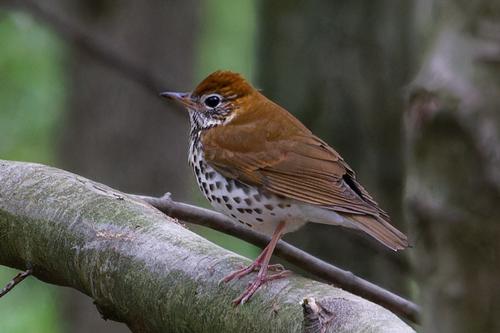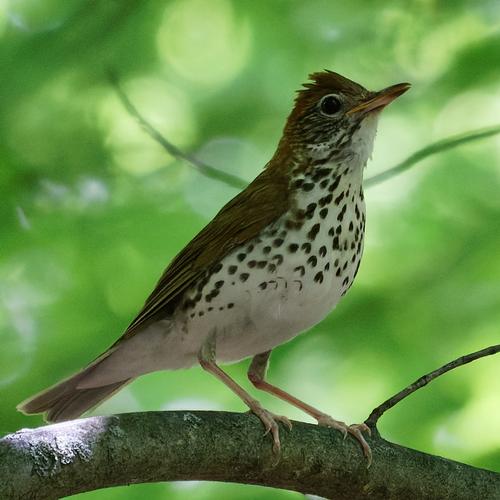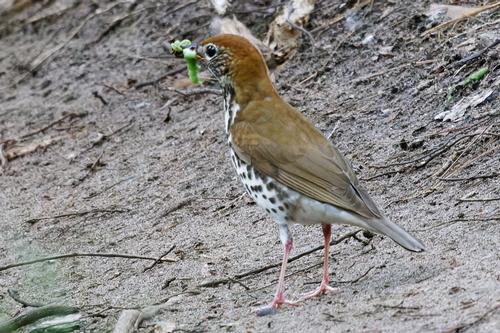Plants and Animals
Hylocichla mustelina Wood thrush
Key Characteristics
A medium sized thrush, measuring 7.5-8 in (19-21 cm) in length. Reddish-brown crown and nape fading to brownish-olive across the back, wings and tail. Large, dark speckles sharply contrast with a white breast, belly, and sides. Males and females similar. Juveniles with tawny streaks on the back, neck and wings. The wood thrush is distinguished from other thrushes by the combination of its dark and clearly defined spotting and its ruddy brown coloring. Song quite variable, in three parts a) a low introductory phrase b) the easily recognized and flute-like "ee-oh-lay" c) a high trill-like termination phrase.
Status and Rank
US Status: No Status/Not Listed
State Status: SC - Special Concern (rare or uncertain; not legally protected)
Global Rank: G4 - Apparently secure
State Rank: S4 - Apparently secure
Occurrences
| County | Number of Occurrences | Year Last Observed |
|---|---|---|
| Crawford | 2 | 2024 |
| Kent | 1 | 2024 |
| Oakland | 1 | 2023 |
| Roscommon | 1 | 2024 |
| Washtenaw | 3 | 2024 |
Information is summarized from MNFI's database of rare species and community occurrences. Data may not reflect true distribution since much of the state has not been thoroughly surveyed.
Habitat
Wood thrushes inhabit upland mesic deciduous forests throughout their breeding range, with preference for a well-developed understory with moist soils and a diversity of tree and shrub species They forage in litter, making an open forest floor with substantial litter ideal foraging habitat.
Natural Community Types
For each species, lists of natural communities were derived from review of the nearly 6,500 element occurrences in the MNFI database, in addition to herbarium label data for some taxa. In most cases, at least one specimen record exists for each listed natural community. For certain taxa, especially poorly collected or extirpated species of prairie and savanna habitats, natural community lists were derived from inferences from collection sites and habitat preferences in immediately adjacent states (particularly Indiana and Illinois). Natural communities are not listed for those species documented only from altered or ruderal habitats in Michigan, especially for taxa that occur in a variety of habitats outside of the state.
Natural communities are not listed in order of frequency of occurrence, but are rather derived from the full set of natural communities, organized by Ecological Group. In many cases, the general habitat descriptions should provide greater clarity and direction to the surveyor. In future versions of the Rare Species Explorer, we hope to incorporate natural community fidelity ranks for each taxon.
Management Recommendations
Protect and maintain large blocks (> 100 ha) of unfragmented forest. Promote reforestation of gaps between smaller forest patches to increase connectivity. Manage forests to increase the ratio of interior to edge. Management activities that mimic small scale natural disturbances and create gaps in the canopy, such as selective logging of single trees, may benefit this species by promoting a well-developed understory, but should be done outside of the nesting season (second week of May to third week of August). Limiting over browsing by deer will also benefit this species.
Management Avoidance Period: From second week of May to third week of August
Active Period
Migration from third week of April to third week of May
Migration from fourth week of August to third week of October
Nesting from second week of May to third week of August
Survey Methods
Surveys for this species are typically point counts or transects through suitable habitat during the breeding season.
Point count, transect
Survey Period: From first week of May to fourth week of June
Time of Day: Morning (sunrise)
References
Survey References
- Bibby, C.J., N.D. Burgess, and D.A. Hill. 1992. Bird Census Techniques. Academic Press, New York.
Technical References
- Evans, M., Gow, E., Roth, R. R., Johnson, M. S., and Underwood, T. J. 2020. Wood Thrush (Hylocichla mustelina), version 1.0. In Birds of the World (A. F. Poole, Editor). Cornell Lab of Ornithology, Ithaca, NY, USA.
- Ng, A. M. B., and A. P. Kortenhoven. 2025. Species Abstract for Hylocichla mustelina (wood thrush). Michigan Natural Features Inventory, Lansing, Michigan, USA.




